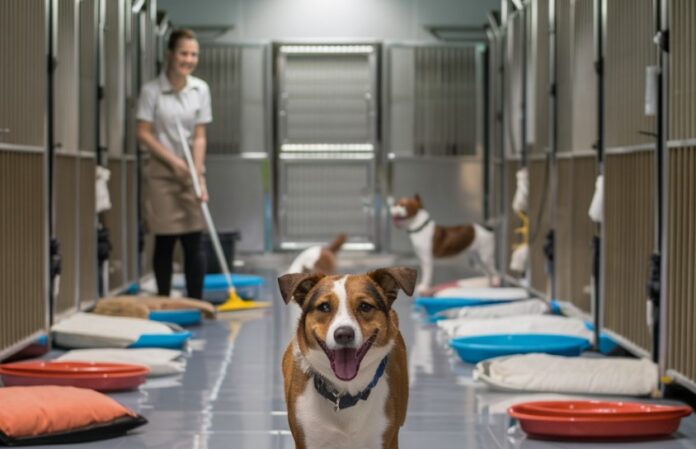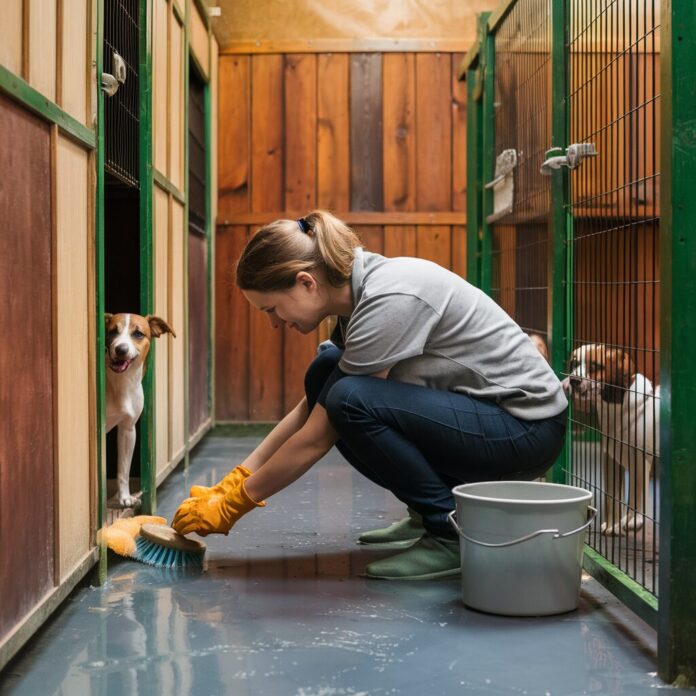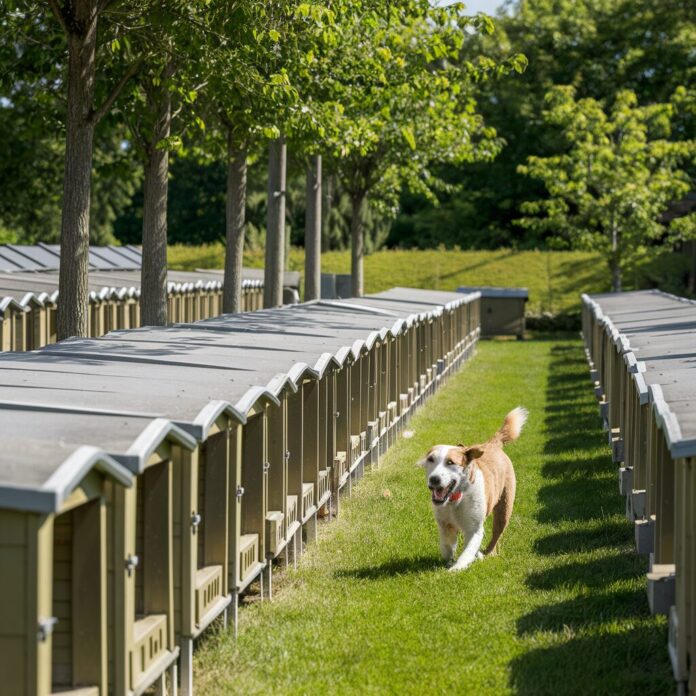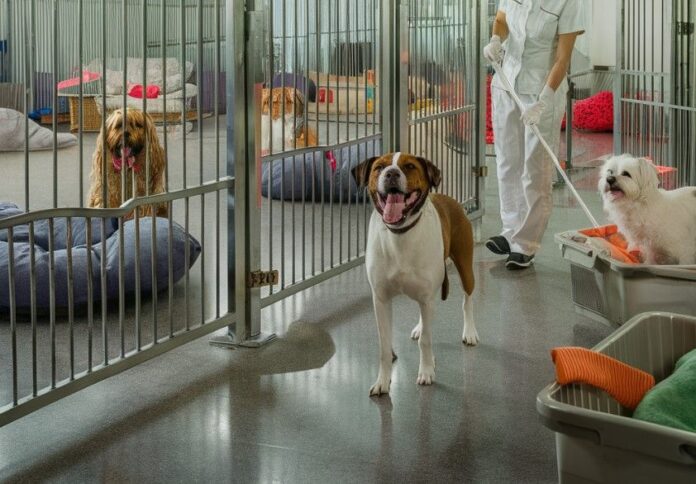Maintaining a clean and sanitary environment in kennels is crucial for the health and well-being of animals.
Kennel disinfection helps prevent the spread of infectious diseases, controls odors, and ensures a safe space for pets. If you want to buy kennel cleaner, check out zwingerreiniger.
This comprehensive guide will delve into the importance of kennel disinfection, the frequency at which it should be done, and the best practices and tips for effective disinfection.
Why Is Kennel Disinfection Necessary?


1. Disease Prevention
Kennels are often high-traffic areas where numerous animals come and go. This makes them prime locations for the spread of infectious diseases such as kennel cough, parvovirus, and distemper. Regular disinfection reduces the presence of harmful pathogens, significantly lowering the risk of disease transmission.
2. Odor Control
Accumulated waste and unclean environments can lead to unpleasant odors, making the kennel uncomfortable for both the animals and the staff. Effective disinfection not only kills bacteria and viruses but also helps control and eliminate foul smells.
3. Animal Comfort and Well-being
Animals, like humans, thrive in clean environments. A sanitized kennel reduces stress and anxiety in pets, contributing to their overall well-being. Clean spaces are particularly important for animals recovering from illness or surgery, as their immune systems are often compromised.
4. Compliance with Health Regulations
Many regions have strict health regulations governing the operation of kennels. Regular disinfection ensures compliance with these standards, preventing potential fines and closures. Adhering to these regulations demonstrates a commitment to providing a safe and healthy environment for animals.
How Often Should Kennel Disinfection Occur?
The frequency of kennel disinfection depends on various factors, including the size of the facility, the number of animals housed, and the specific needs of the animals. However, there are general guidelines that can be followed:
1. Daily Cleaning
- Spot Cleaning: Daily spot cleaning involves the removal of visible waste and debris. This includes cleaning up urine, feces, and spilled food immediately to prevent the growth of bacteria and the spread of pathogens.
- Food and Water Bowls: These should be washed and sanitized daily to prevent the growth of bacteria and mold.
- Bedding and Toys: Wash or replace bedding and toys regularly, ideally daily, to ensure they remain clean and free from contaminants.
2. Weekly Deep Cleaning
- Entire Kennel Area: Perform a thorough cleaning of the entire kennel area at least once a week. This includes washing floors, walls, and any other surfaces that come into contact with animals.
- Disinfectants: Use appropriate disinfectants that are effective against a wide range of pathogens. Ensure the disinfectant is safe for use around animals and follow the manufacturer’s instructions for dilution and contact time.
3. Monthly or Bi-Monthly Disinfection
- HVAC Systems and Ventilation: Clean and disinfect HVAC systems and ventilation ducts monthly or bi-monthly to prevent the spread of airborne pathogens.
- Outdoor Areas: If the kennel has outdoor areas, these should also be disinfected monthly to control the spread of parasites and other pathogens.
Tips and Tricks for Effective Kennel Disinfection
1. Choose the Right Disinfectant
Selecting an effective disinfectant is crucial. Look for products that are:
- Broad-spectrum: Effective against a wide range of pathogens, including bacteria, viruses, fungi, and parasites.
- Safe for Animals: Non-toxic and safe for use around pets.
- EPA-Approved: Ensure the disinfectant is approved by the Environmental Protection Agency (EPA) for use in animal care facilities.
2. Proper Dilution and Contact Time
Follow the manufacturer’s instructions for the correct dilution of the disinfectant. Using the proper concentration ensures the effectiveness of the disinfectant. Additionally, allow the disinfectant to remain on surfaces for the recommended contact time to ensure it kills all pathogens.
3. Use Personal Protective Equipment (PPE)
When handling disinfectants, it’s important to use personal protective equipment such as gloves, masks, and goggles. This protects staff from exposure to potentially harmful chemicals and pathogens.
4. Establish a Cleaning Routine


Develop a structured cleaning and disinfection routine to ensure all areas of the kennel are addressed. Assign specific tasks to staff members and keep a checklist to track daily, weekly, and monthly cleaning activities.
5. Educate and Train Staff
Provide regular training to staff on proper cleaning and disinfection techniques. This includes instruction on the correct use of disinfectants, PPE, and the importance of adhering to established cleaning schedules.
6. Pay Attention to High-Touch Areas
High-touch areas, such as door handles, light switches, and shared equipment, should be disinfected frequently. These areas can harbor pathogens and contribute to the spread of diseases if not properly sanitized.
7. Ventilation and Air Quality
Ensure proper ventilation in the kennel to reduce the concentration of airborne pathogens. Good air circulation helps maintain a healthier environment and reduces the risk of respiratory infections.
8. Monitor and Record Cleaning Activities
Keep detailed records of all cleaning and disinfection activities. This helps in monitoring compliance with cleaning schedules and provides documentation for regulatory inspections.
Effective Disinfection Techniques
1. Mechanical Cleaning
Before applying disinfectants, perform mechanical cleaning to remove organic matter. This involves scrubbing surfaces with soap and water to remove dirt, feces, and other debris. Mechanical cleaning enhances the effectiveness of disinfectants by reducing the presence of organic matter that can inhibit their action.
2. Fogging and Misting
Fogging and misting are techniques used to apply disinfectants in fine droplets, ensuring even coverage over large areas. These methods are particularly useful for disinfecting hard-to-reach places and ensuring comprehensive sanitation.
3. Ultraviolet (UV) Light
UV light is an effective disinfection method that can be used in addition to chemical disinfectants. UV light kills pathogens by damaging their DNA, making it a useful tool for sterilizing surfaces and air.
4. Steam Cleaning
Steam cleaning uses high-temperature steam to disinfect surfaces. It is an eco-friendly method that does not require chemical disinfectants, making it ideal for sensitive areas and equipment.
Conclusion


Regular and thorough disinfection of kennels is essential for preventing disease, controlling odors, and ensuring the comfort and well-being of animals. By following the outlined tips and tricks, kennel operators can create a safe and healthy environment for their furry guests. Establishing a consistent cleaning routine, using effective disinfectants, and educating staff are key components of a successful disinfection strategy. By prioritizing cleanliness, kennels can provide a high standard of care and maintain compliance with health regulations, ensuring the safety and happiness of all animals in their care.







